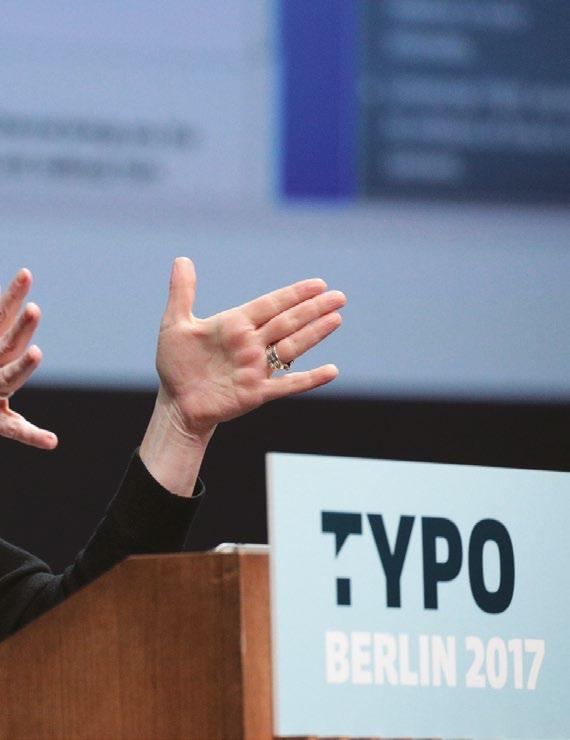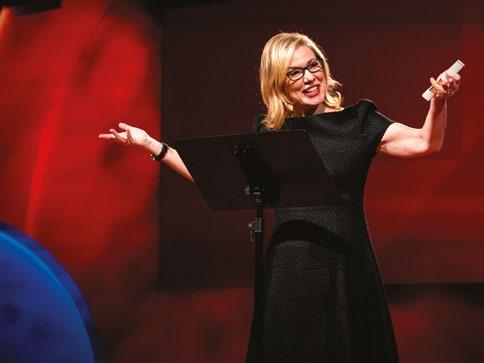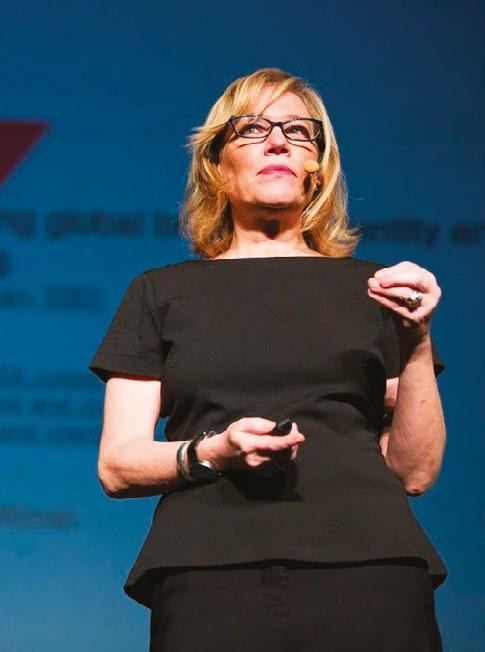
13 minute read
Deliberate differentiation
“A brand’s DNA is incumbent upon the inherent desire for design to be part of a person’s genetic blueprint,” opined moderator Marc Rosen, of the Marc Rosen Education Fund, at the recent Pratt Institute by Design Symposium 2017. “Today design is not just for the sophisticated few. Instead, the mantra of stores like Target is design appreciation for all, knowing [that] the design gene lives within all of us.” The Pratt symposium focused on design as a state of mind that informs every discipline. “How people interact, select, and share design has become a norm. Design is experiential, aspirational, and essential in our daily lives,” added Rosen. Lead panelist Debbie Millman (an author, educator, and strategist) runs the first-ever Master’s in Branding Program at the School of Visual Arts, and is the founding host of the long-running podcast Design Matters. Over an illustrious career trajectory, Millman has had the opportunity to investigate the relationship between design and branding. “Putting this presentation together, a Winston Churchill quote came to mind: ‘We shape our buildings; thereafter, they shape us.’ I had the same question about branding and design. Is branding the birthplace of design or is design the birthplace of branding? I don’t have an easy answer because, perhaps, it’s a little of both. Branding is a very interesting profession. It’s not actually a discipline; you don’t do branding, you do a lot of other things that result in the development of a brand.” Millman sees “branding as a process of manufacturing meaning. We create a construct around this thing, then people agree on those attributes, whether it’s something that has to do with efficacy, pain relief, or athletic prowess.
Sterling Brands Logos, New York City, Cincinnati, San Francisco
Advertisement
Design is the intentional communication of that meaning. Branding allows you to understand what something actually is and design gives you the sense of what it can do.” Branding begins with the boldest gestures of a corporation in terms of ideas and works down to the tiniest iterations of every communication touchpoint. “The only way to build a great brand is from the inside, to understand the brand intention. Why do we need another brand of bottled water? Why do we need another running shoe? There must be a reason for that brand to exist. Defining Brand, Deliberate Differentiation “My definition of branding is very simple,” Millman continued. “I wrote a book about the definition of branding from branding experts’ opinions, interviewed 20 of the greatest minds in branding and got 20 definitions. I wanted to distill these learnings into one simple telegraphic definition…” “Branding is deliberate differentiation.” Deliberate differentiation is the result of intentional, strategic positioning. Intentional is what you intend to happen, meaning that you are starting out on a path that has distinct criteria for success. “Take the word ‘strategic.’ When I speak at colleges, the students think they know what it means. But, in fact, when I talk about strategy I mean the classic Michael Porter, Harvard Business School definition of strategy, which is really one of two things: It’s either to choose to perform activities differently or to perform distinctly different activities than do rivals.” Performing activities differently is the way Starbucks launched its brand. There were lots of coffee shops before Starbucks came along, but Howard Schwartz recreated the experience and the expectation of what you could get when you buy a coffee. Apple is a brand that’s performed distinctlydifferent activities than its rivals, not with the iPhone but with the iPod, which was

released in 2001. “There were lots of MP3 players in the market, but what Apple did differently was to create iTunes, something entirely different that changed the game. If you can do one of those two things, [then] you have a legitimate ability to say that you are working strategically to communicate your brand,” added Millman. Positioning and the Brand Journey Positioning is about the journey that gets one to the brand. In Millman’s view, “Branding isn’t really a discipline. It’s about sound, strategic positioning that allows you to intentionally determine where you are going in the future. That journey results in developing a brand.” Branding as a discipline includes four elements: 1.Cultural anthropology: Understand what is happening in the world to subsequently understand our constructs, our reality. 2.Behavioral psychology: If you’re not able to understand why somebody wants something or why they tell you they want something, why they tell you they want something, then you’ll never be able to engage their imagination. 3.Economics: Understand what is valuable. Millman believes that people want what they believe is valuable in their lives and will find a way to acquire it. 4.Creativity: We can only comprehend about 40 of the 10 million images that we see on any given day, so you need a design that will engage a person’s spirit. Branding, a Profound Manifestation “We’re living in a remarkable age. For the first time ever as a species, branding has become democratized,” added Millman. “It is no longer just about a profit and loss statement or shareholder value. Branding has become a profound manifestation of the human spirit, the human condition. It’s about belonging to a tribe, to a religion, to a family. Our ability to brand our beliefs gives us that sense of belonging.”


HOW SYMBOLS AND BRANDS SHAPE OUR HUMANITY
Thirteen point eight billion years ago, the universe as we know it began with a big bang, and everything that we know and are and are made of was created. Fifty thousand years ago, our brains underwent a major genetic mutation, which resulted in the biological reorganization of the brain. Some scientists call this “The Big Brain Bang.” Others call it “The Great Leap Forward,” which I prefer. It’s so much more poetic. This is when Homo sapiens began to evolve into the modern species that we are today. The Great Leap Forward activated most of our modern abilities: abstract thought, planning, cooking, competitive labor, language, art, music and self-decoration. After the Great Leap Forward, there was an explosion of stone toolmaking, more sophisticated weaponry and, 32,000 years ago, the creation of our first sophisticated mark-making on the cave walls of Lascaux. It’s not a coincidence that we’ve gone from documenting our reality on the cave walls of Lascaux to the walls of Facebook. And, in a very meta experience, you can now a book a trip to see the walls of Lascaux on the walls of Facebook. Approximately 10,000 years ago, men and women began to array themselves with makeup. They started to self-decorate. But this wasn’t for seductive purposes; this was for religious convictions. We wanted to be more beautiful, purer, cleaner in the eyes of something or someone that we believed had more power than we did. There is no culture in recorded human history that has not practiced some form of organized worship, which we now call “religion.” Six thousand years ago, in an effort to unite people, our ancestors began to design telegraphic symbols to represent beliefs

and to identify affiliations. These symbols connected like-minded people, and they are all extraordinary. These affiliations allowed us to feel safer and more secure in groups, and the sharing created consensus around what the symbols represented. With these marks, you knew where you fit in, both for the people that were in the in crowd and those, as importantly, that were excluded. These symbols were created in what I consider to be a very bottom-up manner: they were made by people for people and then shared for free among people to honor the higher power that they ascribed to. What’s ironic is that the higher power actually had nothing to do with this. These early affiliations, they often shared identical characteristics, which is rather baffling given how scattered we were all over the planet.
Debbie Millman, TEDWomen 2019, December 2019
We constructed similar rituals, practices and behaviors no matter where we were anywhere on the globe. We constructed rituals to create symbolic logos. We built environments for worship. We developed strict rules on how to engage with each other with food, with hair, with birth, with death, with marriage and procreation. Some of the symbols have eerie commonalities. The hand of God shows up over and over and over again. It shows up as the hamsa hand in Mesopotamia. It shows us as the hand of Fatima in Islam. It shows up as the hand of Miriam in Judaism. Now, when we didn’t agree on what our beliefs and behaviors were in regards to others, if we felt that somebody else’s were incorrect, we began to fight, and many of our first wars were religious. Our flags were used on the battlefield to signify which side of the battlefield we belonged
Slide presentation from TEDWomen 2019
to, because that was the only way to be able to tell friend from foe. We all looked alike. And now our flags are on mass-manufactured uniforms that we are making. Logos on products to identify a maker came next, and brands were given legal recognition on January 1, 1876, with the advent of the Trademarks Registration Act. The first trademarked brand was Bass Ale, and I kind of wonder what that says about our humanity that first trademarked brand was an alcoholic beverage. Now, here is what I consider to be the first case of branded product placement. There are bottles of Bass Ale behind me with the logo accurately presented here in this very famous painting in 1882 by Édouard Manet. One of the most widely recognized logos in the world today is the Nike swoosh, which was introduced in 1971. Carolyn Davidson, a graphic design student, originally created the logo for 35 dollars. Upon seeing it, Nike CEO Phil Knight stated, “I don’t love it but maybe it will grow on me.” Maybe it will grow on me. But why is the swoosh so popular? Why is the swoosh so popular? Is it the mark? Or is the marketing? And what can we make of the fact that the Nike swoosh seems to be the Newport logo upside down or the Capital One logo on its side? That is not the only logo with a shared identity. This next logo is a logo that has a shared identity with wholly different meanings. As a Jewish person, I believe that this logo, this swastika, is the most heinous logo of all time. But it actually has a rather surprising trajectory. The word “swastika” originally comes from the ancient Sanskrit word “svastika,” which actually means “good fortune,” “luck” and “wellbeing.” In the early 1900s, before it was appropriated by Hitler, it was used by Coca-Cola on a good luck bottle opener.
Slide presentation from TEDWomen 2019
The American Biscuit Company prominently registered the mark and put it on boxes of cookies. The US Playing Card Company registered the mark in 1921 for Fortune Playing Cards. The Boy Scouts used the mark on shoes in 1910, and the symbol was also featured on cigar labels, boxtops, road signs and even poker chips. Even the Jain made use of the logo along with a hand of God many millennia ago. These marks were identical, but with use as a Nazi symbol, the impact became very, very different. The hand of God, the Nike swoosh and the swastika: they all demonstrate how we’ve been manufacturing meaning with visual language over millennia. It’s a behavior that’s almost as old as we are. Today, in the United States, there are over 116,000 malls, and they all look pretty much the same. There are more than 40,000 supermarkets, and they each have over 40,000 items. If you went shopping for bottled water, you’d have over 80 options to choose from. Since their launch in 1912, you could choose from over 100 flavors and variants of Oreo cookies. Now, is this a good thing or is it a bad thing? Is a plethora of choice necessary in a free market? I believe it is both a good and bad thing, as humans are both good and bad, and we’re the ones creating and using and buying these brands. However, I think that the question of whether this behavior is good or bad is actually secondary to understanding why – why we behave this way in the first place. Here’s the thing: every one of our mass-marketed products are what I consider to be top-down brands. They’re still created by people, but they are owned, operated, manufactured, advertised, designed, promoted and distributed by the corporation and pushed down and sold to
the consumer for financial gain. These corporations have a responsibility to a P and L with an expectation of an ROI and have names like P and G and AT and T and J and J. And that’s pretty much the way it’s been for the last couple of hundred years: a top-down model controlled by the corporation. Until 2011. That’s when we began to see evidence of real, significant, far-reaching change. The Arab Spring and Occupy Wall Street proved how the internet could amplify messages and connect like-minded people with powerful beliefs to inspire change. We witnessed a cultural shift via social media with hashtags like #MeToo

and #BlackLivesMatter. In its wake, the discipline of branding has transformed more in the last 10 years than it has in the last 10,000, and for the first time in modern history, the most popular, influential brands are not brands being pushed down by the corporation. They are brands being pushed up by the people, for the people, for the sole purpose of changing the world and making it a better place. Our greatest innovations aren’t brands providing a different form or a different flavor of our favorite snack. Our greatest innovations are the creation of brands that can make a difference in our lives and reflect the kind of world that we want to live in.
Debbie Millman, TEDWomen 2019, December 2019

In November of 2016, Krista Suh, Jayna Zweiman and Kat Coyle created a hat to be worn at the Women’s March in Washington, DC. This was the day after the presidential inauguration. Two months later, on January 21, 2017, millions of people all over the world wore handmade pink pussyhats in support of the Women’s March all over the world. The hat was not created for any financial benefit. Like our religious symbols created thousands of years ago, the hat wascreated by the people, for the people to serve what I believe is the highest benefit of branding: to unite people in the communication of shared ideals. The pink pussyhat became a mark for a movement. In a very short time, two months, it became universally recognizable. It connected an audience in an unprecedented way. It is a brand, but it is more than that. Today, the pink pussyhat is proof positive that branding is not just a tool of capitalism. Branding is the profound manifestation of the human spirit. The condition of branding has always reflected the condition of our culture. It is our responsibility to continue to leverage the democratic power branding provides, and it is our responsibility to design a culture that reflects and honors the kind of world we want to live in. Thank you.
Skillshare | How Brands Work in Our Brains with Debbie Millman











